check engine RENAULT SCENIC 2011 J95 / 3.G Engine And Peripherals Siemens Injection Workshop Manual
[x] Cancel search | Manufacturer: RENAULT, Model Year: 2011, Model line: SCENIC, Model: RENAULT SCENIC 2011 J95 / 3.GPages: 329, PDF Size: 1.71 MB
Page 295 of 329

13B-295
MR-372-J84-13B050$897.mif
V17
Siemens Injection
SID301 and 304
Vdiag No.: 44-45-48-49-4D-4C
Program No.: B1 and B2DIESEL INJECTION
Fault finding – Fault Finding Chart13B
NO
End of procedure.
ALP 19
CONTINUED 2
Is an oil leak present at the turbocharger oil supply inlet or outlet?
YESNO
Check the turbocharger oil supply inlet and
outlet
Check for a loose interface (inlet or outlet) that is
the cause of the oil leak.
Is the suspected interface properly
tightened?
YES
Only replace the seal or pipe of the part concerned (see MR 364 (Mégane II), 370 (Scénic II), 417
(Kangoo II), 385 (Modus), 392 (Clio III), Mechanical, 12B, turbocharging).
Is an oil leak present at the interfaces of the turbine casing and the exhaust pipes?
YES
The turbocharger is not faulty. There is probably another fault in the engine.
Mark the component from which arises the leak and refer to the repair manual (see MR 364 (Mégane II), 370
(Scénic II), 417 (Kangoo II), 385 (Modus), 392 (Clio III), 10A Engine and Peripherals).
NOTighten the pipe concerned.
End of procedure.
AFTER REPAIRCarry out a road test followed by a complete check with the diagnostic tool.
B
Page 296 of 329
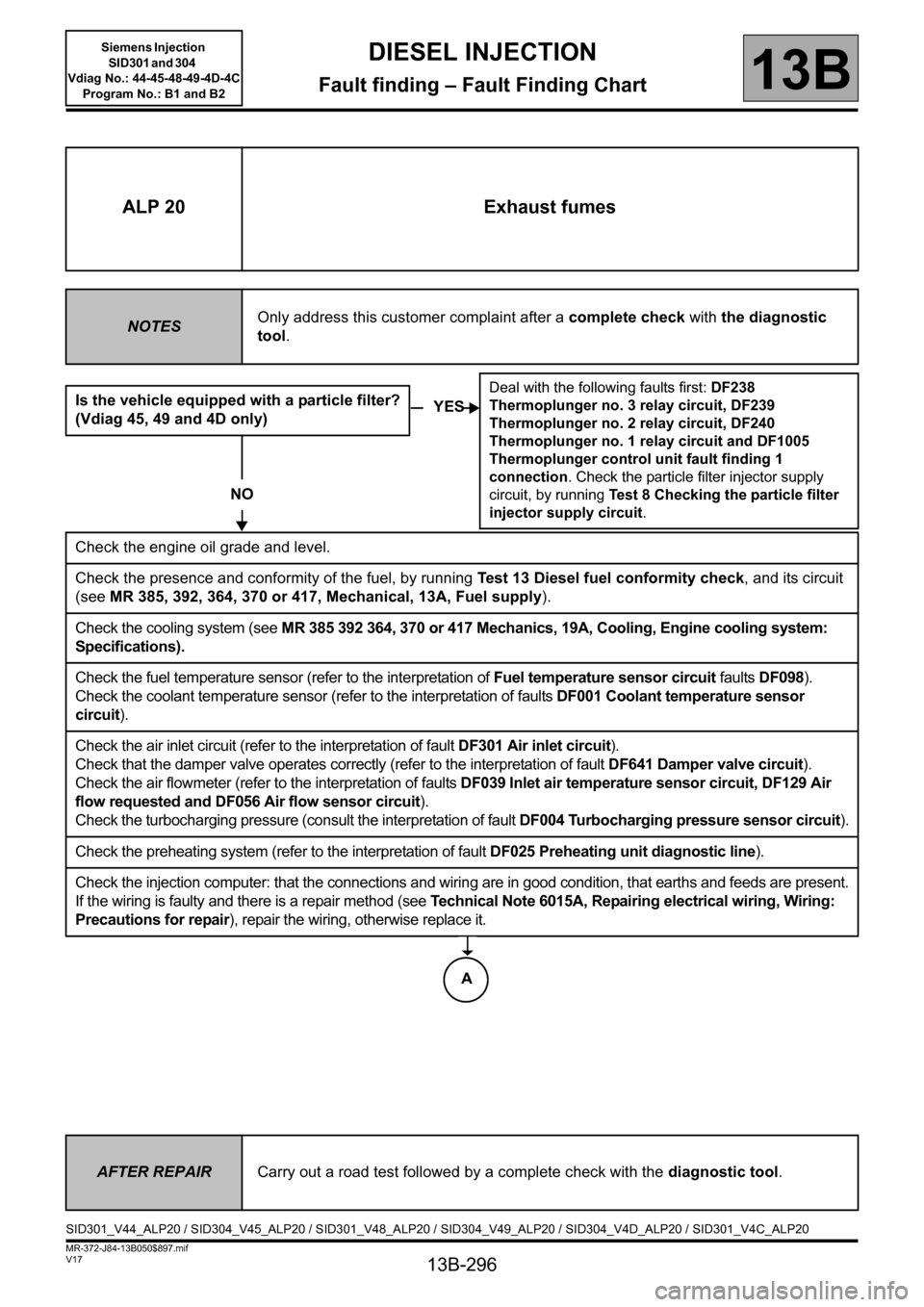
13B-296
MR-372-J84-13B050$897.mif
V17
Siemens Injection
SID301 and 304
Vdiag No.: 44-45-48-49-4D-4C
Program No.: B1 and B2DIESEL INJECTION
Fault finding – Fault Finding Chart13B
ALP 20 Exhaust fumes
NOTESOnly address this customer complaint after a complete check with the diagnostic
tool.
Is the vehicle equipped with a particle filter?
(Vdiag 45, 49 and 4D only)
NO
Check the engine oil grade and level.
Check the presence and conformity of the fuel, by running Test 13 Diesel fuel conformity check, and its circuit
(see MR 385, 392, 364, 370 or 417, Mechanical, 13A, Fuel supply).
Check the cooling system (see MR 385 392 364, 370 or 417 Mechanics, 19A, Cooling, Engine cooling system:
Specifications).
Check the fuel temperature sensor (refer to the interpretation of Fuel temperature sensor circuit faults DF098).
Check the coolant temperature sensor (refer to the interpretation of faults DF001 Coolant temperature sensor
circuit).
Check the air inlet circuit (refer to the interpretation of fault DF301 Air inlet circuit).
Check that the damper valve operates correctly (refer to the interpretation of fault DF641 Damper valve circuit).
Check the air flowmeter (refer to the interpretation of faults DF039 Inlet air temperature sensor circuit, DF129 Air
flow requested and DF056 Air flow sensor circuit).
Check the turbocharging pressure (consult the interpretation of fault DF004 Turbocharging pressure sensor circuit).
Check the preheating system (refer to the interpretation of fault DF025 Preheating unit diagnostic line).
Check the injection computer: that the connections and wiring are in good condition, that earths and feeds are present.
If the wiring is faulty and there is a repair method (see Technical Note 6015A, Repairing electrical wiring, Wiring:
Precautions for repair), repair the wiring, otherwise replace it.
YES
Deal with the following faults first: DF238
Thermoplunger no. 3 relay circuit, DF239
Thermoplunger no. 2 relay circuit, DF240
Thermoplunger no. 1 relay circuit and DF1005
Thermoplunger control unit fault finding 1
connection. Check the particle filter injector supply
circuit, by running Test 8 Checking the particle filter
injector supply circuit.
AFTER REPAIRCarry out a road test followed by a complete check with the diagnostic tool.
SID301_V44_ALP20 / SID304_V45_ALP20 / SID301_V48_ALP20 / SID304_V49_ALP20 / SID304_V4D_ALP20 / SID301_V4C_ALP20
A
Page 297 of 329
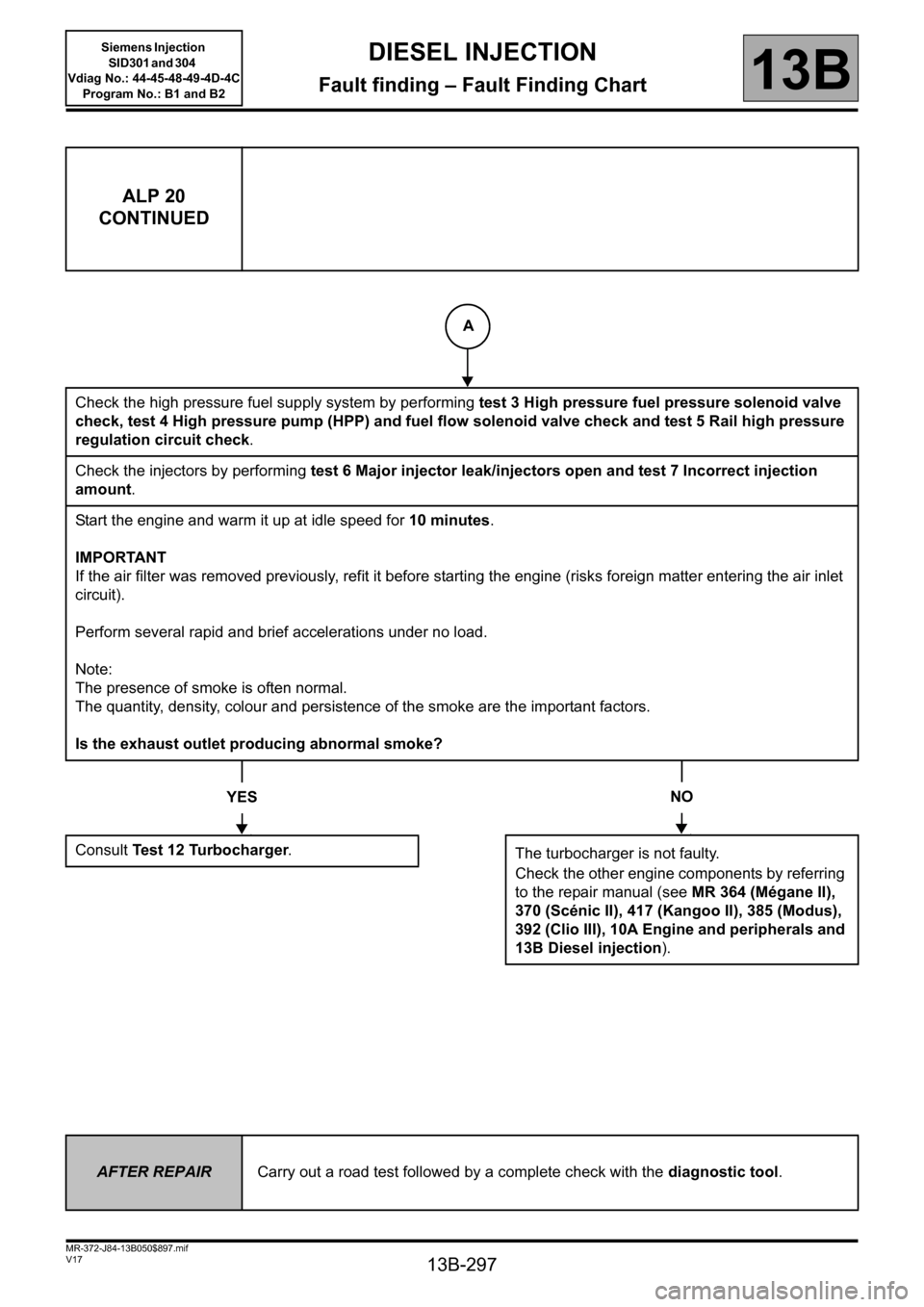
13B-297
MR-372-J84-13B050$897.mif
V17
Siemens Injection
SID301 and 304
Vdiag No.: 44-45-48-49-4D-4C
Program No.: B1 and B2DIESEL INJECTION
Fault finding – Fault Finding Chart13B
ALP 20
CONTINUED
Check the high pressure fuel supply system by performing test 3 High pressure fuel pressure solenoid valve
check, test 4 High pressure pump (HPP) and fuel flow solenoid valve check and test 5 Rail high pressure
regulation circuit check.
Check the injectors by performing test 6 Major injector leak/injectors open and test 7 Incorrect injection
amount.
Start the engine and warm it up at idle speed for 10 minutes.
IMPORTANT
If the air filter was removed previously, refit it before starting the engine (risks foreign matter entering the air inlet
circuit).
Perform several rapid and brief accelerations under no load.
Note:
The presence of smoke is often normal.
The quantity, density, colour and persistence of the smoke are the important factors.
Is the exhaust outlet producing abnormal smoke?
YES
Consult Te s t 1 2 Tu r b o c h a r g e r.
NO
The turbocharger is not faulty.
Check the other engine components by referring
to the repair manual (see MR 364 (Mégane II),
370 (Scénic II), 417 (Kangoo II), 385 (Modus),
392 (Clio III), 10A Engine and peripherals and
13B Diesel injection).
AFTER REPAIRCarry out a road test followed by a complete check with the diagnostic tool.
A
Page 301 of 329

13B-301
MR-372-J84-13B050$936.mif
V17
13B
DIESEL INJECTION
Fault finding – Tests
Some special checks are grouped under the heading Tests and are used as required in different fault
finding charts (ALP) or interpretation of faults.
*Technical Note 3419: Fault finding on the turbocharger for petrol and diesel engines
NOTESOnly consult these tests when dealing with a fault finding chart (ALP) or when
interpreting faults.
Low pressure fuel supply system check. TEST 1
Internal fuel transfer pump (ITP) check. TEST 2
High pressure fuel pressure solenoid valve check. TEST 3
Check high-pressure pump (HPP) and fuel flow solenoid valve. TEST 4
Rail high pressure control circuit check. TEST 5
Major leak in injectors/injectors open. TEST 6
Incorrect injection quantity. TEST 7
Particle filter injector supply circuit check.
Only for Vdiag 45, 49 and 4D.TEST 8
Particle filter history.
Only for Vdiag 45, 49 and 4D.TEST 9
Turbocharger air chain. TEST 10
Turbocharger control solenoid valve.TEST 11: Apply
TEST 4 of
Technical Note
3419*
Turbocharger.TEST 12: Apply
TEST 7 of
Technical Note
3419*
Diesel fuel conformity check. TEST 13
MR-372-J84-13B050$936.mif
Siemens Injection
SID301 and 304
Vdiag No.: 44-45-48-49-4D-4CProgram No.: B1 and B2
Page 302 of 329
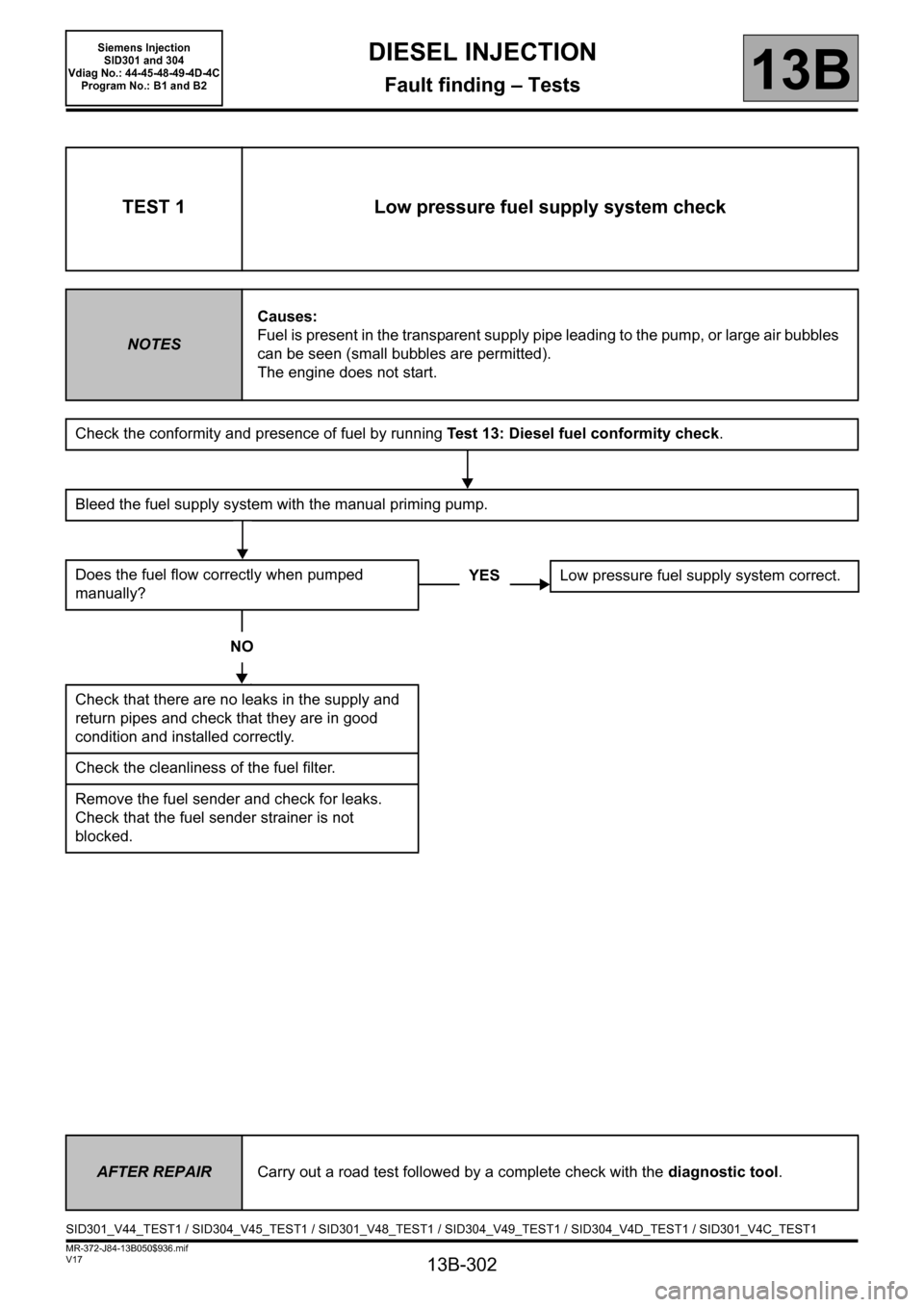
13B-302
MR-372-J84-13B050$936.mif
V17
DIESEL INJECTION
Fault finding – Tests13B
Siemens Injection
SID301 and 304
Vdiag No.: 44-45-48-49-4D-4C
Program No.: B1 and B2
TEST 1 Low pressure fuel supply system check
NOTESCauses:
Fuel is present in the transparent supply pipe leading to the pump, or large air bubbles
can be seen (small bubbles are permitted).
The engine does not start.
Check the conformity and presence of fuel by running Test 13: Diesel fuel conformity check.
Bleed the fuel supply system with the manual priming pump.
Does the fuel flow correctly when pumped
manually?
NO
Check that there are no leaks in the supply and
return pipes and check that they are in good
condition and installed correctly.
Check the cleanliness of the fuel filter.
Remove the fuel sender and check for leaks.
Check that the fuel sender strainer is not
blocked.
YESLow pressure fuel supply system correct.
AFTER REPAIRCarry out a road test followed by a complete check with the diagnostic tool.
SID301_V44_TEST1 / SID304_V45_TEST1 / SID301_V48_TEST1 / SID304_V49_TEST1 / SID304_V4D_TEST1 / SID301_V4C_TEST1
Page 307 of 329
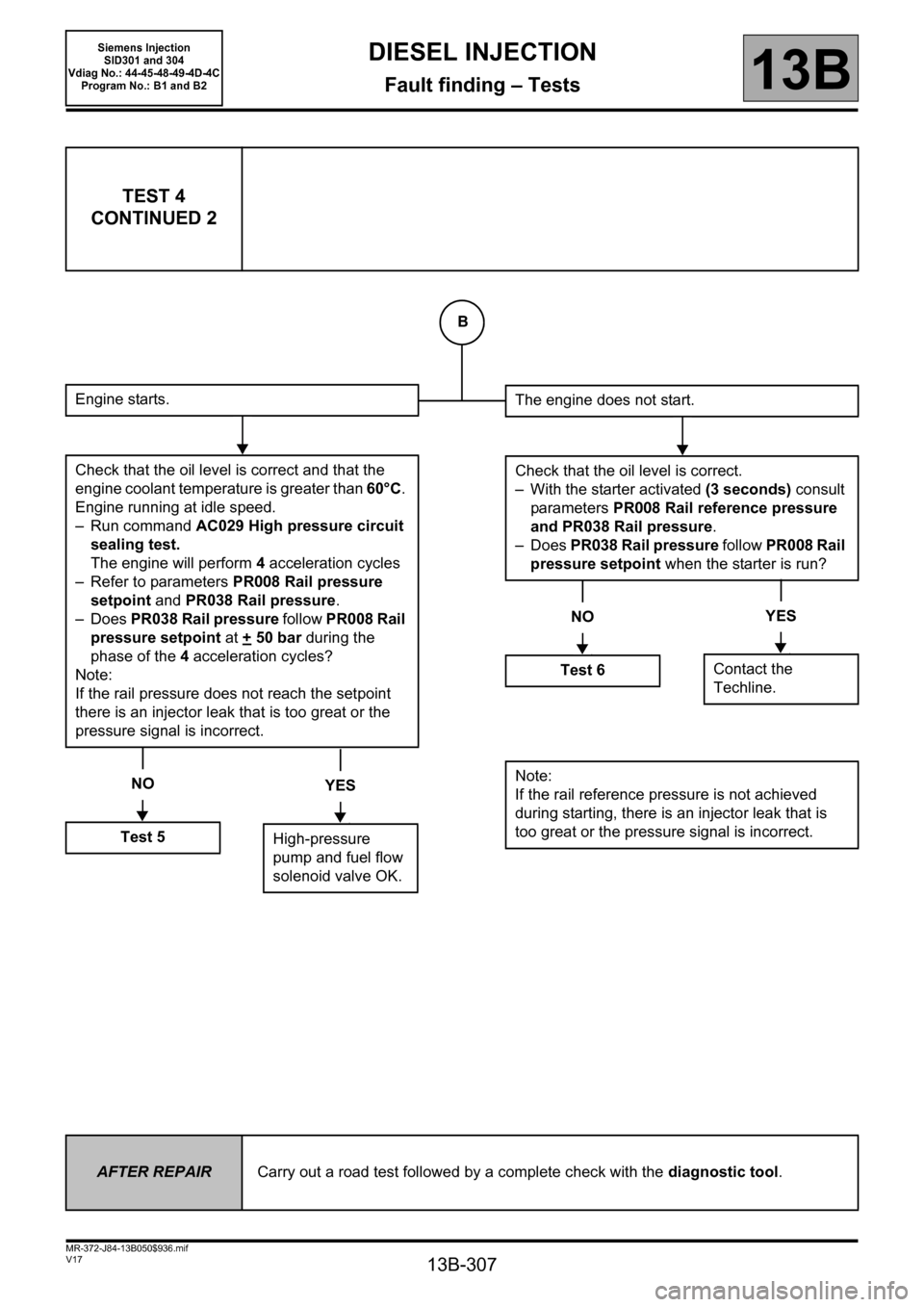
13B-307
MR-372-J84-13B050$936.mif
V17
Siemens Injection
SID301 and 304
Vdiag No.: 44-45-48-49-4D-4C
Program No.: B1 and B2DIESEL INJECTION
Fault finding – Tests13B
TEST 4
CONTINUED 2
Engine starts.
Check that the oil level is correct and that the
engine coolant temperature is greater than 60°C.
Engine running at idle speed.
– Run command AC029 High pressure circuit
sealing test.
The engine will perform 4acceleration cycles
– Refer to parameters PR008 Rail pressure
setpoint and PR038 Rail pressure.
–Does PR038 Rail pressure follow PR008 Rail
pressure setpoint at +
50 bar during the
phase of the 4 acceleration cycles?
Note:
If the rail pressure does not reach the setpoint
there is an injector leak that is too great or the
pressure signal is incorrect.
NO
Test 5
YES
High-pressure
pump and fuel flow
solenoid valve OK.
The engine does not start.
Check that the oil level is correct.
– With the starter activated (3 seconds) consult
parameters PR008 Rail reference pressure
and PR038 Rail pressure.
–Does PR038 Rail pressure follow PR008 Rail
pressure setpoint when the starter is run?
NO
Test 6
YES
Contact the
Techline.
Note:
If the rail reference pressure is not achieved
during starting, there is an injector leak that is
too great or the pressure signal is incorrect.
AFTER REPAIRCarry out a road test followed by a complete check with the diagnostic tool.
B
Page 308 of 329
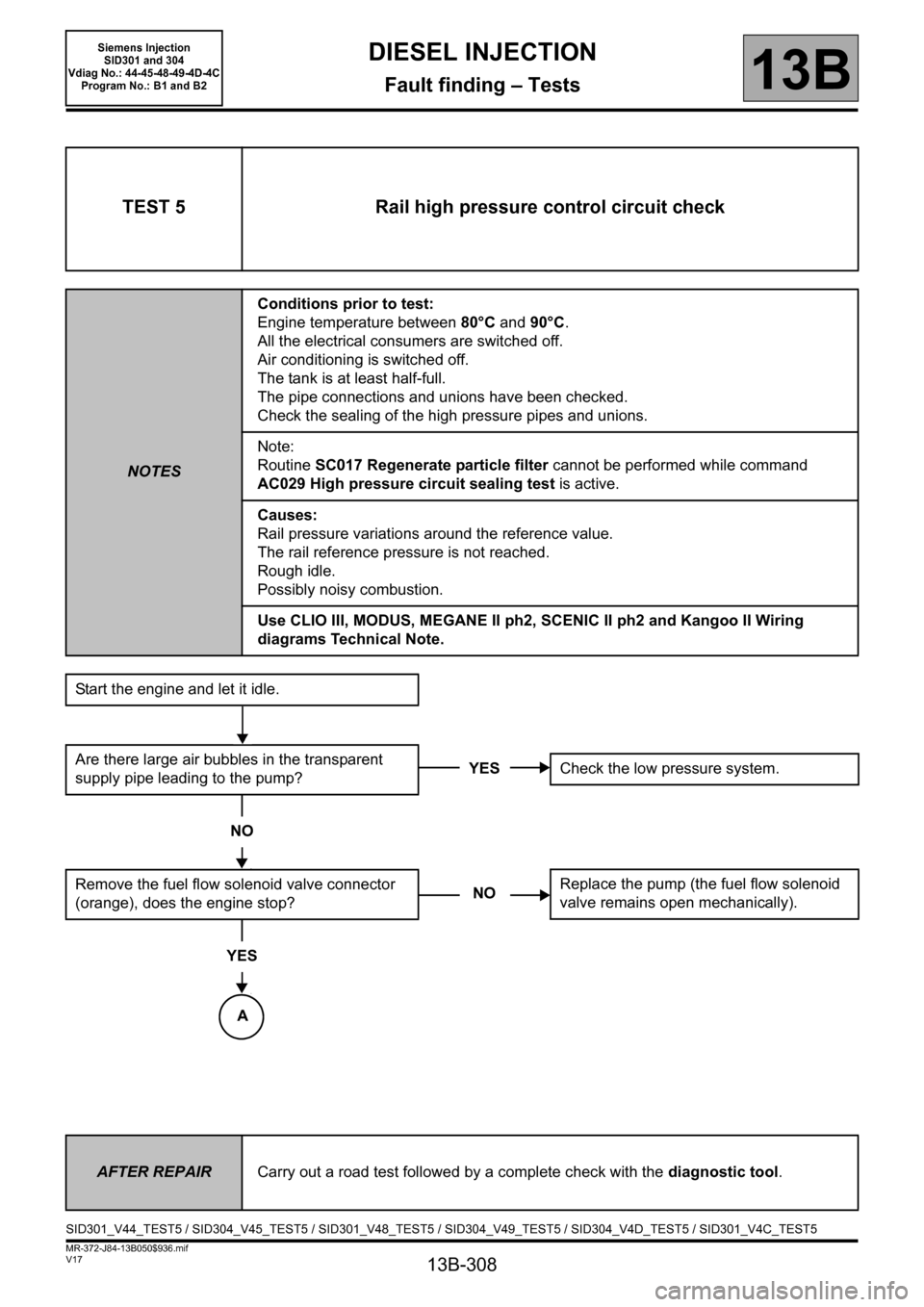
13B-308
MR-372-J84-13B050$936.mif
V17
DIESEL INJECTION
Fault finding – Tests13B
Siemens Injection
SID301 and 304
Vdiag No.: 44-45-48-49-4D-4C
Program No.: B1 and B2
TEST 5 Rail high pressure control circuit check
NOTESConditions prior to test:
Engine temperature between 80°C and 90°C.
All the electrical consumers are switched off.
Air conditioning is switched off.
The tank is at least half-full.
The pipe connections and unions have been checked.
Check the sealing of the high pressure pipes and unions.
Note:
Routine SC017 Regenerate particle filter cannot be performed while command
AC029 High pressure circuit sealing test is active.
Causes:
Rail pressure variations around the reference value.
The rail reference pressure is not reached.
Rough idle.
Possibly noisy combustion.
Use CLIO III, MODUS, MEGANE II ph2, SCENIC II ph2 and Kangoo II Wiring
diagrams Technical Note.
Start the engine and let it idle.
Are there large air bubbles in the transparent
supply pipe leading to the pump?
NO
Remove the fuel flow solenoid valve connector
(orange), does the engine stop?
YES
YESCheck the low pressure system.
NOReplace the pump (the fuel flow solenoid
valve remains open mechanically).
AFTER REPAIRCarry out a road test followed by a complete check with the diagnostic tool.
SID301_V44_TEST5 / SID304_V45_TEST5 / SID301_V48_TEST5 / SID304_V49_TEST5 / SID304_V4D_TEST5 / SID301_V4C_TEST5
A
Page 309 of 329
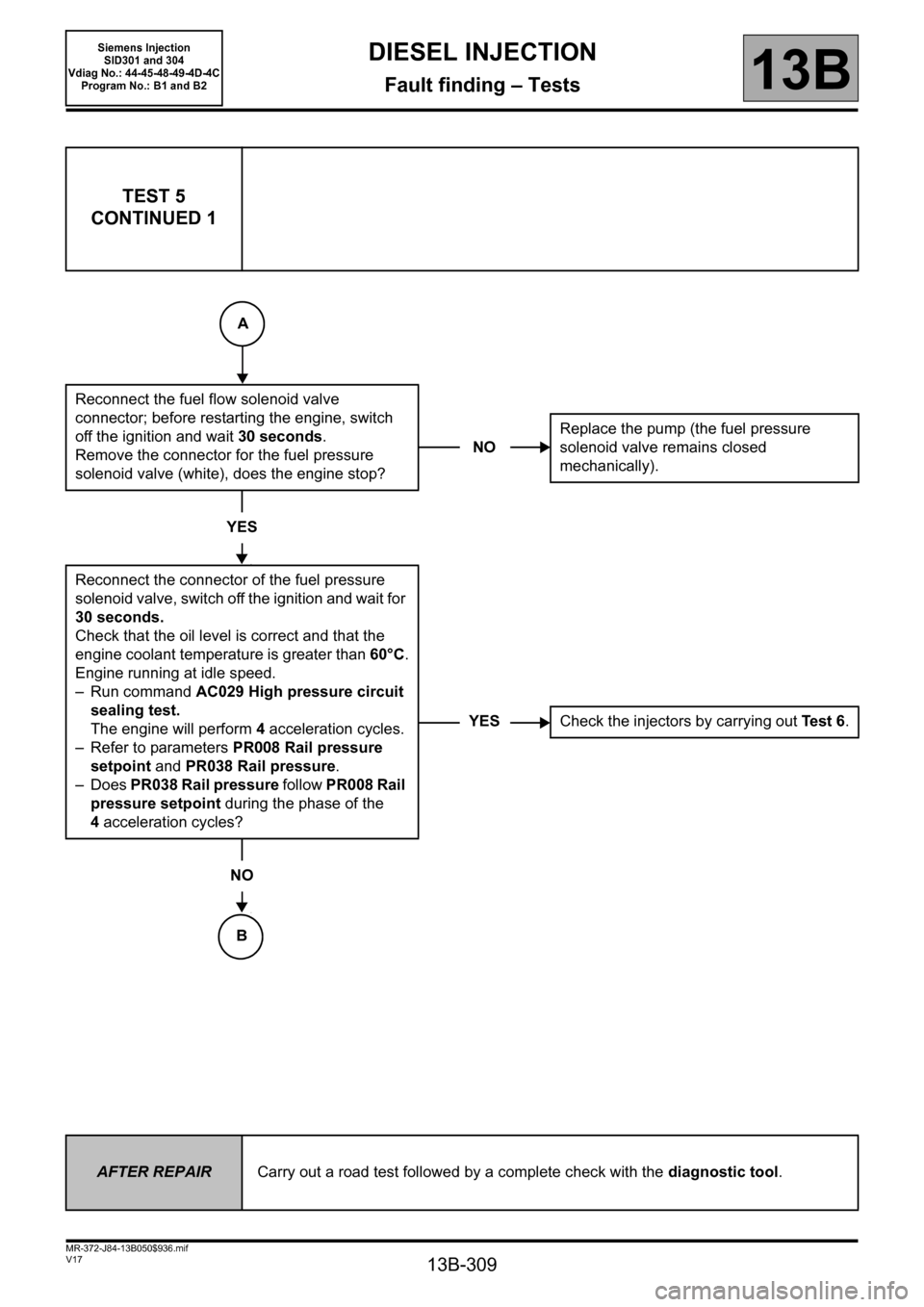
13B-309
MR-372-J84-13B050$936.mif
V17
DIESEL INJECTION
Fault finding – Tests13B
Siemens Injection
SID301 and 304
Vdiag No.: 44-45-48-49-4D-4C
Program No.: B1 and B2
TEST 5
CONTINUED 1
Reconnect the fuel flow solenoid valve
connector; before restarting the engine, switch
off the ignition and wait 30 seconds.
Remove the connector for the fuel pressure
solenoid valve (white), does the engine stop?
YES
Reconnect the connector of the fuel pressure
solenoid valve, switch off the ignition and wait for
30 seconds.
Check that the oil level is correct and that the
engine coolant temperature is greater than 60°C.
Engine running at idle speed.
– Run command AC029 High pressure circuit
sealing test.
The engine will perform 4acceleration cycles.
– Refer to parameters PR008 Rail pressure
setpoint and PR038 Rail pressure.
–Does PR038 Rail pressure follow PR008 Rail
pressure setpoint during the phase of the
4acceleration cycles?
NO
NOReplace the pump (the fuel pressure
solenoid valve remains closed
mechanically).
YESCheck the injectors by carrying out Te s t 6.
AFTER REPAIRCarry out a road test followed by a complete check with the diagnostic tool.
A
B
Page 310 of 329

13B-310
MR-372-J84-13B050$936.mif
V17
DIESEL INJECTION
Fault finding – Tests13B
Siemens Injection
SID301 and 304
Vdiag No.: 44-45-48-49-4D-4C
Program No.: B1 and B2
TEST 5
CONTINUED 2
Restore parameters PR063 Fuel temperature and PR064 Coolant temperature.
Fuel temperature reference value when operating at idle speed is between 60 °C and 80 °C.
The coolant temperature reference value is between 80 °C and 90 °C.
Note:
– when the fuel temperature is above 120°C, the maximum rail pressure is reduced to protect the plastic pipes,
– when the coolant temperature is above 100°C, the maximum rail pressure is reduced to protect the engine.
Are the fuel and coolant temperatures within the
reference value range?
YES
NOCheck the coolant temperature (see the
interpretation of DF001 Coolant
temperature sensor circuit) and fuel
temperature sensors (see the
interpretation of DF098 Fuel temperature
sensor circuit).
AFTER REPAIRCarry out a road test followed by a complete check with the diagnostic tool.
B
C
Page 312 of 329
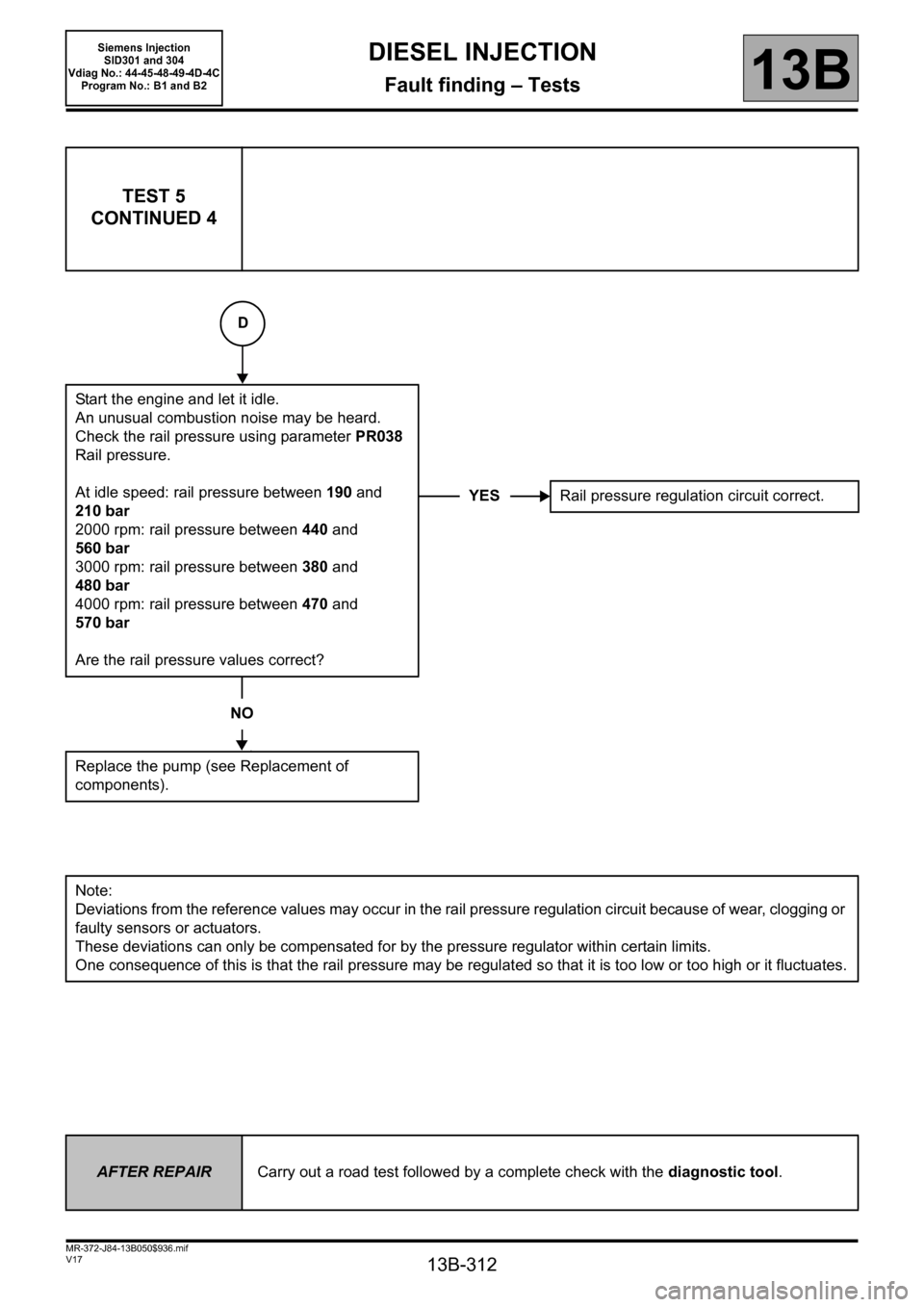
13B-312
MR-372-J84-13B050$936.mif
V17
DIESEL INJECTION
Fault finding – Tests13B
Siemens Injection
SID301 and 304
Vdiag No.: 44-45-48-49-4D-4C
Program No.: B1 and B2
TEST 5
CONTINUED 4
Start the engine and let it idle.
An unusual combustion noise may be heard.
Check the rail pressure using parameter PR038
Rail pressure.
At idle speed: rail pressure between 190 and
210 bar
2000 rpm: rail pressure between 440 and
560 bar
3000 rpm: rail pressure between 380 and
480 bar
4000 rpm: rail pressure between 470 and
570 bar
Are the rail pressure values correct?
NO
Replace the pump (see Replacement of
components).
Note:
Deviations from the reference values may occur in the rail pressure regulation circuit because of wear, clogging or
faulty sensors or actuators.
These deviations can only be compensated for by the pressure regulator within certain limits.
One consequence of this is that the rail pressure may be regulated so that it is too low or too high or it fluctuates.
YESRail pressure regulation circuit correct.
AFTER REPAIRCarry out a road test followed by a complete check with the diagnostic tool.
D